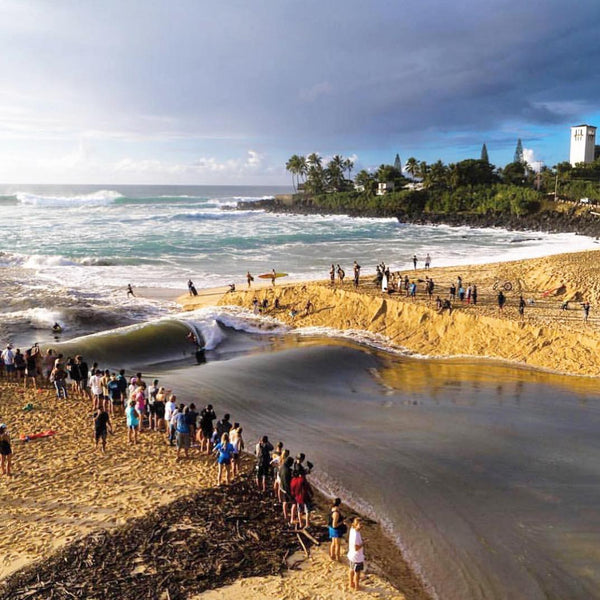The Making of the Waimea Bay River Break
Share
The Making of the Waimea Bay River Break

📷 @vwhonolulu
Most of us here in Hawaii have seen footage of the standing wave at Waimea Bay, which forms when the river flows out of Waimea Valley and breaks through the beach.
Have you ever wondered when and how that standing wave forms, or how long it lasts?
We did some research into the formation of the “Waimea River Break,” and what we found out was actually pretty unsurprising.
First of all, Waimea Bay is one of the biggest waves on the North Shore—this isn’t really news to anyone. Over the summer and winter, sand gets moved around the North Shore by currents and waves (again, not exactly revelatory news), and since Waimea Bay has some of the biggest waves and strongest currents on the coast, it is no surprise that sand builds up on the beach, making it a great place for people to enjoy the sun, watch people charge huge waves in the winter, and jump off the famous Waimea Jump Rock during the summer.
Most of us also realize that winter can be a bit rainy on Oahu—When the rain really gets going, Waimea River starts to flow out of the valley, but with all the sand that gets built up on the beach, the river isn’t able to empty into the bay, which is its natural endpoint. The water eventually starts to backfill the valley and the marsh behind Waimea Bay beach, which actually isn’t great for the local environment, since the river naturally wants to empty into the ocean.
Left to its own devices, the river will typically either break through on its own, or eventually dissipate as the winter rains come to an end. But with so many miscreants (aka: surfers) living on the North Shore, it’s been years since the river has been left to its own devices! Once the water gets close to breaking over the sand berm, a bunch of locals takes matters into their own hands. They dig out a trench through the berm, connect the trench to the backed up water, and within a few hours, the flowing river has torn open the beach and emptied its guts into Waimea Bay. And in the meantime, it creates a pretty fun (if not short-lived) standing wave.
The legality of digging out the river is questionable, but at the end of the day, no one really complains. After all, no one is doing anything that nature doesn’t do on its own—they are just speeding up the process so that it happens during daylight hours, when the wave can be enjoyed by everyone. (That being said, the river does usually tend to get dugout in the evening, once the authorities have gone home, so the river sessions often extend until long after sunset). And everyone is welcome to come and enjoy the fun; it’s more of a community event than anything. All you need is a shovel, a board, and the willingness to work a bit for your waves—and the inside scoop on which everyone is going to show up and break the river open, of course.
Next time you see a long period of rain followed by a major flat spell on the North Shore, head on over to Waimea Bay, and you just might ride the longest wave of your life!
Frequently asked Questions
What is the Waimea Bay River Break?
The Waimea Bay river break is a powerful and dangerous shore break that occurs where the Waimea River meets the ocean at Waimea Bay. During periods of large surf, waves rebound off the shallow river bottom and nearby rocky shoreline, creating unpredictable and turbulent conditions.
When does the river break happen?
The river break is most active during large winter swells on the North Shore, typically between November and February. Waves over 15-20 feet face height start to create the intense river break conditions.
Why is it so dangerous?
The combination of rebounding wave energy, shallow depths, rocky bottoms and shoreline make the Waimea river mouth extremely hazardous. The chaotic wave action can easily injure or kill unsuspecting people by slamming them into the rocks or shallow bottom.
Who surfs the river break?
Only the most experienced big wave surfers will attempt to ride the unpredictable Waimea river break during the largest swells. It requires expert timing, positioning and water safety knowledge to navigate safely.
Can I watch it?
Yes, spectating from the beach or lookouts is possible but extremely inadvisable to get near the river mouth itself during large surf. Rogue waves have swept spectators into the turbulent river break with tragic results.The power and chaos of the Waimea Bay river break makes it both an amazing spectacle of nature's power and an incredibly hazardous area to be near during winter on Oahu's North Shore.
MORE TO READ...

1件のコメント
nerds wheres the date is made